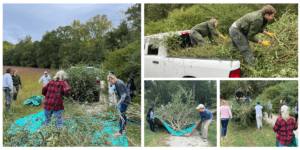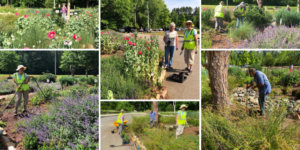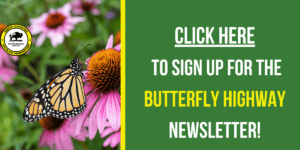Taking Action Against Invasive Plants in North Carolina – National Invasive Species Awareness Week Blog 1

– Written by Luke Bennett, NCWF Conservation Coordinator
In recognition of National Invasive Species Awareness Week (February 20-26), NCWF is highlighting the top invasive plant and animal species in North Carolina through a two-part blog series and through facilitating ongoing community efforts to address invasive plant species affecting North Carolina wildlife and habitat.
To find out about invasive wildlife species in North Carolina, check out our companion blog: Taking Action Against Invasive Wildlife in North Carolina – National Invasive Species Awareness Week Blog 2.
Invasive plants are one of the largest detrimental factors facing native ecosystems in North Carolina… but how can plants really be such a bad thing?
We’ve got you covered.
What is an invasive species – and why are they such a problem?
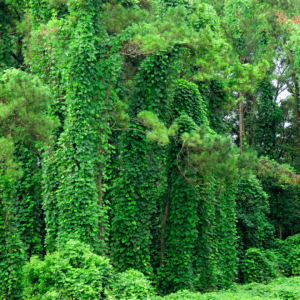
Kudzu, a harmful invasive species, blankets all forms of plant life in its path, decimating native plant life.
An invasive species is any living organism — plant, animal, insect or microbe — that is introduced to an area outside of its original range and causes harm to the environment, the economy, or even human health. Invasive animal species, like invasive plant species, pose significant problems to ecosystem health.
Over the last century, scientists and ecologists such as EO Wilson, Aldo Leopold, and – more recently – Doug Tallamy have drawn comparisons between biological systems and man-made machines. Like a machine, an ecosystem functions at its best when all of its parts function in tandem with one another.
Ecosystems can also be viewed as what Aldo Leopold calls a “land community” or a “biotic community”. Similar to the machine metaphor, ecosystems function like communities, with plant, animal, insect, microbe, and even human members. These communities across the globe have evolved to work together over thousands of years. Over time, the members of such communities have become acquainted with each other and – in one way or another – mutually benefit one another. Symbiotic relationships may not always look friendly – such as in predator and prey dynamics – but the relationship is nevertheless beneficial to the ecosystem, as a whole.
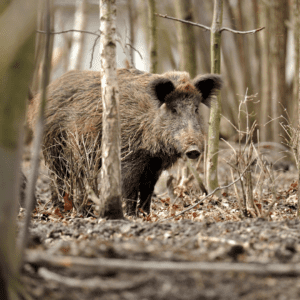
Wild pigs are just one example of invasive species that are harmful to native North Carolina ecosystems.
As you can imagine, when one member of a community – or one part of the machine – is removed from its native ecosystem, it is not only adverse for that species but for the ecosystem that it benefits,… hence the significant impacts from species extinction. However, the same may apply when a species is introduced into a community where it has not existed before. When invasive species are introduced, they present a new and unfamiliar dynamic of competition to biological communities and the members within them.
Doug Tallamy, author of Nature’s Best Hope, notes that some critics of this “biotic community” claim that many species have been introduced into ecosystems that were not previously their own, and are now contributing members. Take the numerous species that crossed land bridges to different continents thousands of years ago, for instance. However, Tallamy points out that ecosystems are designed to integrate new members over incredibly long periods of time – thousands or even millions for years. This allows the ecosystem time to adapt to its new members and form a niche for them.
In the past few centuries, we have seen the sudden and dramatic introduction of many invasive species into unprepared biotic communities around the world. And – sadly – North Carolina is not exempt.
Invasive Plants in North Carolina
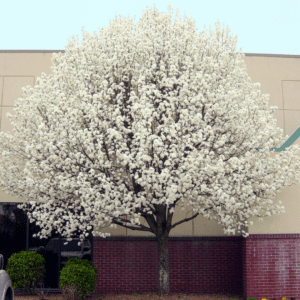
Bradford pear trees are another form of invasive species, prompting NCWF to facilitate the Bradford Pear Bounty Program.
Invasive plant species: Plants that are not indigenous, or native, to a particular area. Invasive plants can cause great economic and environmental harm to the new area because they often spread rapidly and displace native plants, preventing growth and creating monocultures. Introduction of invasive plants often brings a host of environmental repercussions, including but not limited to, decreased plant diversity, increased soil erosion, degraded habitat, and diminished water quality. For a more in depth look at the impact of invasive plants and their impact, read NCWF’s 2022 blog post, Restoring the Balance of Nature: Battling Invasive Plant Species, Preserving Natives.
The North Carolina Native Plant Society, an affiliate of the North Carolina Wildlife Federation, classifies 26 invasive plant species as a severe threat to North Carolina native plants and wildlife. The species listed below are of utmost concern and will be treated as a priority during eradication efforts. There are plenty of other invasive species not listed that pose a threat to native plants and wildlife. These should also be removed if possible.
Tree of heaven (Ailanthus altissima)
Mimosa, silk tree (Albizia julibrissin)
Garlic mustard, hedge garlic (Alliaria petiolata)
Alligator weed (Alliaria petiolata)
Oriental bittersweet (Celastrus orbiculatus)
Russian olive, oleaster (Elaeagnus angustifolia)
Autumn olive, oriental silverleaf (Elaeagnus umbellata)
English ivy, common ivy (Hedera helix)
Hydrilla (Hydrilla verticillata)
Bicolor lespedeza, shrubby lespedeza (Lespedeza bicolor)
Sericea lespedeza, chinese lespedeza (Lespedeza cuneata)
Chinese privet (Ligustrum sinense)
Sweet-breath-of-spring, fragrant honeysuckle (Lonicera fragrantíssima)
Japanese honeysuckle (Lonicera japonica)
Japanese stilt-grass (Microstegium vimineum)
Mud-annie, marsh dewflower (Murdannia keisak)
Parrot-feather (Myriophyllum aquaticum)
Princess tree, empress tree (Paulownia tomentosa)
Common reed, old world reed (Phragmites australis)
Bradford pear, callery pear (Pyrus calleryana)
Japanese knotweed (Reynoutria japonica)
Kudzu (Pueraria montana)
Multiflora rose (Rosa multiflora)
Giant salvinia, kariba weed (Salvinia molesta)
Beach vitex, roundleaf chaste-tree (Vitex rotundifolia)
Chinese wisteria (Wisteria sinensis)
How to Prevent Invasive Plant Species in Your Backyard.
It can be extraordinarily difficult and costly to control or eradicate invasive plants once they are established. The best approach to dealing with invasive plants is to prevent their spread in the first place.
- Learn to identify invasive plants. The Butterfly Highway Newsletter features a different invasive plant species each week and serves as a great starting point for distinguishing between native and invasive plants.
- Verify that any plants you purchase are native to North Carolina. Ask your local nursery staff for help and check out NCWF’s Native Plant Resources.
- Plant native plants. Having a diverse and robust population of native plants in your backyard reduces opportunities for invasive plants to take hold. Check out our list of statewide native plant nurseries!
- Don’t pick the flowers of noxious weeds to take homee and don’t pick or transport flowers you can’t identify. Drive vehicles only on established roads and trails away from weed-infested areas.
- Clean outdoor recreation gear (hiking boots, fishing pole, waders, etc) after each use.
Techniques to Remove Invasive Plant Species in Your Backyard
If you are dealing with an established population of invasive plants there are few options for removal. Different species may require various methods of removal depending on the invasive plant in question and the severity of the infestation.
- Mechanical techniques include mowing, hoeing, tilling, girdling, chopping, and construction barriers using tools or machines.
- Physical or manual techniques include hand-pulling, digging, flooding, mulching, and generally all removal practices that are done by hand.
- Biological control involves the introduction of natural predators for the purpose of controlling invasive plant species. For example, goats have been utilized in some areas as a means to remove kudzu by consumption. In North Carolina, most biological control efforts involve plant-feeding insects. Tread carefully with this option; thorough research and testing is recommended to ensure that the introduced predator only targets the invasive species intended.
-

Once invasive plant species are removed, vibrant native plants are re-introduced by chapter volunteers.
Chemical control of invasive species involves the use of herbicides. Chemical methods can be very effective, but should be applied locally and with caution considering the potential for adverse effects on other species and the broader ecosystem. Spot treatment is preferred over widespread spraying/application.
Source – U.S. Department of Agriculture
North Carolina Wildlife Federation Volunteer Opportunities
Another great way to combat invasive species is by volunteering with North Carolina Wildlife Federation to help remove invasives, plant natives and educate the public about the issue. You can also check out the Bradford Pear Bounty Program, a collaborative effort between NC Wildlife Federation, NC Urban Forest Council, the NC State Extension and the NC Forest Service. Spring is a great time for planting! NCWF and our local community wildlife chapters have a lot of planting, invasive removing, and native plant educating events in the works, so please check the NCWF Calendar frequently for the latest updates!


